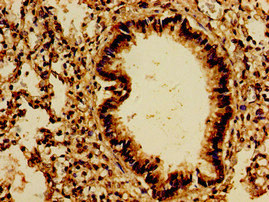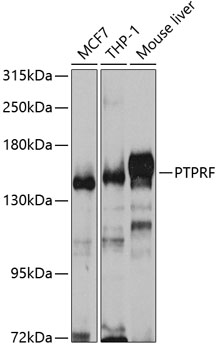PTPRF antibody
GTX82141
ApplicationsWestern Blot
Product group Antibodies
TargetPTPRF
Overview
- SupplierGeneTex
- Product NamePTPRF antibody
- Delivery Days Customer9
- Application Supplier NoteWB: 1:500. *Optimal dilutions/concentrations should be determined by the researcher.Not tested in other applications.
- ApplicationsWestern Blot
- CertificationResearch Use Only
- ClonalityPolyclonal
- ConjugateUnconjugated
- Gene ID5792
- Target namePTPRF
- Target descriptionprotein tyrosine phosphatase receptor type F
- Target synonymsBNAH2, LAR, receptor-type tyrosine-protein phosphatase F, LCA-homolog, leukocyte antigen-related (LAR) PTP receptor, leukocyte antigen-related tyrosine phosphatase, leukocyte common antigen related, protein tyrosine phosphatase, receptor type, F polypeptide, receptor-linked protein-tyrosine phosphatase LAR
- HostChicken
- IsotypeIgY
- Protein IDP10586
- Protein NameReceptor-type tyrosine-protein phosphatase F
- Scientific DescriptionPossible cell adhesion receptor. It possesses an intrinsic protein tyrosine phosphatase activity (PTPase).The protein encoded by this gene is a member of the protein tyrosine phosphatase (PTP) family. PTPs are known to be signaling molecules that regulate a variety of cellular processes including cell growth. differentiation. mitotic cycle. and oncogenic transformation. This PTP possesses an extracellular region. a single transmembrane region. and two tandem intracytoplasmic catalytic domains. and thus represents a receptor-type PTP. The extracellular region contains three Ig-like domains. and nine non-Ig like domains similar to that of neural-cell adhesion molecule. This PTP was shown to function in the regulation of epithelial cell-cell contacts at adherents junctions. as well as in the control of beta-catenin signaling. An increased expression level of this protein was found in the insulin-responsive tissue of obese. insulin-resistant individuals. and may contribute to the pathogenesis of insulin resistance. Two alternatively spliced transcript variants of this gene. which encode distinct proteins. have been reported.
- Storage Instruction-20°C or -80°C,2°C to 8°C
- UNSPSC12352203






